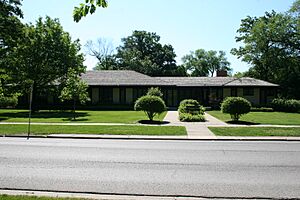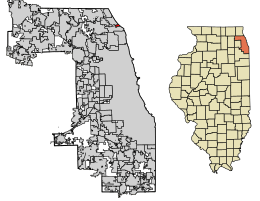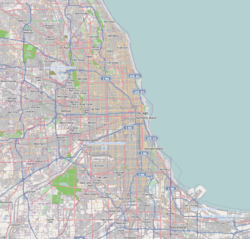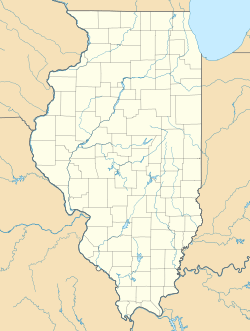Kenilworth, Illinois facts for kids
Quick facts for kids
Kenilworth, Illinois
|
|||
|---|---|---|---|

Kenilworth Club
|
|||
|
|||

Location of Kenilworth in Cook County, Illinois.
|
|||
| Country | |||
| State | Illinois | ||
| County | Cook | ||
| Township | New Trier | ||
| Incorporated | 1889 | ||
| Government | |||
| • Type | Council–manager | ||
| Area | |||
| • Total | 0.61 sq mi (1.57 km2) | ||
| • Land | 0.61 sq mi (1.57 km2) | ||
| • Water | 0.00 sq mi (0.00 km2) 0% | ||
| Elevation | 615 ft (187 m) | ||
| Population
(2020)
|
|||
| • Total | 2,514 | ||
| • Density | 4,141.68/sq mi (1,597.94/km2) | ||
| Up 0.8% from 2000 | |||
| Standard of living (2007-11) | |||
| • Per capita income | $104,301 | ||
| • Median home value | $1,000,000+ | ||
| ZIP code(s) |
60043
|
||
| Area code(s) | 847 & 224 | ||
| Geocode | 17-39519 | ||
| FIPS code | 17-39519 | ||
Kenilworth is a small village in Cook County, Illinois, USA. It's about 15 miles north of Chicago. In 2020, about 2,514 people lived there.
It's the newest of the nine North Shore towns along Lake Michigan. Kenilworth was carefully planned from the start. It is known for being a very wealthy community. In 2018, it was one of the richest towns in the United States.
Contents
History of Kenilworth
Kenilworth was founded in 1889 by a man named Joseph Sears. He bought a large piece of land, about 223 acres, for $150,300. This land was made up of several farms between the Chicago and North Western Railroad and Lake Michigan.
Sears and his friends created The Kenilworth Company. Their goal was to build a special suburban community. Sears had four main ideas for the town: large lots for homes, high building standards, no alleys, and rules about who could buy land. These rules were later changed to allow live-in servants of color.
Selling the Vision
The Kenilworth Company worked hard to promote the new community. They used brochures, maps, and newspaper ads. They even offered transportation from Chicago and overnight stays for people interested in buying land.
In 1891, Sears invited important bankers and businessmen from Chicago to a picnic on Kenilworth's lake shore. He offered land at $60 an acre. This was much more expensive than similar land nearby, which cost about $15 an acre. Even so, all the land sold within a year!
This planned community became very famous. Many well-known architects visited it after attending the 1893 Columbian Exposition in Chicago.
Becoming a Village
On February 4, 1896, Kenilworth had enough residents (300 people) to become an official village. An elected board then took over running the town from Joseph Sears. The Kenilworth Company continued selling land until 1904. After that, Sears owned all the remaining property.
The Kenilworth Company carefully planned every part of the community. They wanted to make sure it followed Joseph Sears's ideas. The village was designed to use the natural beauty of the land. To keep a country feel, the plan included large lots, space between houses, trees along roads, and many parks. Mr. Sears even gave some of his own land for these parks.
Early on, a church, schools, parks, and clubs were added to help build a strong community spirit. A famous architect named Franklin Burnham joined The Kenilworth Company. He designed the railroad station and the Kenilworth Union Church. He also designed several homes to show potential residents what their houses could look like.
Overcoming Challenges
In 1966, the first African American family, the Calhouns, moved to Kenilworth. Some people in the community showed resistance. There was even an incident where a cross was burned, and other acts of vandalism happened. However, many other residents were shocked and supportive.
Walter Calhoun, who was a student and athlete at the time, remembered his friends and neighbors going "above and beyond" to make sure he felt included. Four years later, two teenagers apologized to Harold Calhoun for the cross burning.
Kenilworth's Geography
Kenilworth is a small village. According to information from 2021, it covers about 0.61 square miles (1.57 square kilometers). All of this area is land.
Population and People
| Historical population | |||
|---|---|---|---|
| Census | Pop. | %± | |
| 1900 | 336 | — | |
| 1910 | 881 | 162.2% | |
| 1920 | 1,188 | 34.8% | |
| 1930 | 2,501 | 110.5% | |
| 1940 | 2,935 | 17.4% | |
| 1950 | 2,789 | −5.0% | |
| 1960 | 2,959 | 6.1% | |
| 1970 | 2,980 | 0.7% | |
| 1980 | 2,708 | −9.1% | |
| 1990 | 2,402 | −11.3% | |
| 2000 | 2,494 | 3.8% | |
| 2010 | 2,513 | 0.8% | |
| 2020 | 2,514 | 0.0% | |
| US Census Bureau | |||
As of the 2020 census, 2,514 people lived in Kenilworth. There were 730 households and 639 families. The village had about 4,142 people per square mile.
Most residents (89.1%) were White. About 4.2% were Asian, and 0.4% were African American. About 4.1% of the population was Hispanic or Latino.
Many households (43.4%) had children under 18 living with them. Most households (80.3%) were married couples. The average household had 3.44 people.
The median age in the village was 43.5 years. About 33.0% of the population was under 18.
| Race / Ethnicity (NH = Non-Hispanic) | Pop 2000 | Pop 2010 | Pop 2020 | % 2000 | % 2010 | % 2020 |
|---|---|---|---|---|---|---|
| White alone (NH) | 2,398 | 2,412 | 2,207 | 96.15% | 95.98% | 87.79% |
| Black or African American alone (NH) | 4 | 7 | 8 | 0.16% | 0.28% | 0.32% |
| Native American or Alaska Native alone (NH) | 1 | 0 | 2 | 0.04% | 0.00% | 0.08% |
| Asian alone (NH) | 56 | 33 | 105 | 2.25% | 1.31% | 4.18% |
| Pacific Islander alone (NH) | 0 | 0 | 0 | 0.00% | 0.00% | 0.00% |
| Other race alone (NH) | 0 | 0 | 12 | 0.00% | 0.00% | 0.48% |
| Mixed race or Multiracial (NH) | 1 | 20 | 77 | 0.04% | 0.80% | 3.06% |
| Hispanic or Latino (any race) | 34 | 41 | 103 | 1.36% | 1.63% | 4.10% |
| Total | 2,494 | 2,513 | 2,514 | 100.00% | 100.00% | 100.00% |
Arts and Culture in Kenilworth
Kenilworth has many interesting places and groups:
- Kenilworth Fountain – This fountain is in the middle of Kenilworth Avenue, just east of the railroad tracks.
- The Kenilworth Beach – This is the public beach on Lake Michigan. It has areas for sailing and swimming.
- Pee Wee Field – Also called "Sears Stadium," this baseball field is where many little league games are played.
- Townley Field – This sports field is behind the school. Many sports like field hockey, soccer, and football are played here.
- The Ware Garden – A public courtyard on the east side where people often walk their dogs.
- Mahoney Park – A small park named after a farm that used to be there when the town was founded.
- Kenilworth Train Station – This is a train station on the Metra Line.
- The Kenilworth Club – A community house that hosts many events all year.
- Kenilworth Historical Society – This group works to save and share the town's history.
- Kenilworth Union Church – A non-denominational Protestant church on Kenilworth Avenue.
- Church of the Holy Comforter – An Episcopal Church across the street from Kenilworth Union.
- Hiram Baldwin House – A famous Prairie School house designed by Frank Lloyd Wright in 1905.
Public Services in Kenilworth
Kenilworth has its own police department. However, it does not have its own fire department. Instead, the town works with the fire department in the nearby town of Winnetka.
For library services, the Kenilworth Public Library District works with the Wilmette Public Library District. All 9-1-1 emergency calls are handled by Glenview Public Safety Dispatch.
The Village of Kenilworth also has a Public Works Department. This department takes care of streets, trees, village buildings, and traffic signals. The Kenilworth Park District maintains parks and provides fun activities for residents.
Education in Kenilworth
Kenilworth has its own public school district. The only school in this district is Joseph Sears School. It is named after the founder of the village.
This school, often called Sears, teaches students from junior kindergarten through eighth grade. There are usually about sixty students in each grade. Kenilworth is also part of the New Trier Township High School District. This district has campuses in Northfield (for freshmen) and Winnetka (for older students).
Transportation in Kenilworth
The Kenilworth station offers train service. These Metra commuter trains travel south to Ogilvie Transportation Center in Chicago. They also go north to Kenosha station. Bus service in the village is provided by Pace.
Notable People from Kenilworth
Many interesting people have connections to Kenilworth:
- Frances Badger, a painter and muralist, was born here.
- Debra Cafaro, a business leader and part-owner of the Pittsburgh Penguins hockey team.
- Julia Collins, a champion on the TV show Jeopardy!.
- Robert Dold, a former Republican United States Congressman.
- Walker Evans, a famous photographer from the Great Depression era.
- Paul Harvey, a well-known radio news commentator.
- Christopher George Kennedy, son of Robert F. Kennedy and Ethel Kennedy.
- Mark Kirk, a former Republican United States Senator from Illinois.
- George Washington Maher, an important architect from the Chicago area.
- James McManus, a professional poker player.
- Charles H. Percy, a former Republican United States Senator from Illinois.
- Jude Reyes, a billionaire and co-owner of Reyes Holdings, Inc.
- Liesel Pritzker Simmons, an actress, millionaire, and giver of money to good causes.
- Bradley Roland Will, an activist, videographer, and journalist.
- Terence H. Winkless, a film director.
Images for kids
See also
 In Spanish: Kenilworth (Illinois) para niños
In Spanish: Kenilworth (Illinois) para niños








